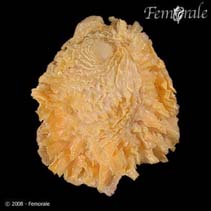Chama macerophylla Gmelin, 1791
Leafy jewelbox| Native range | All suitable habitat | Point map | Year 2050 |

|
| This map was computer-generated and has not yet been reviewed. |
| Chama macerophylla AquaMaps Data sources: GBIF OBIS |
Classification / Names Populärnamn | synonymer | CoL | ITIS | WoRMS
Bivalvia | Venerida | Chamidae
Environment: milieu / climate zone / djupintervall / distribution range Ekologi
; djupintervall 0 - 525 m (Ref. 83435). Tropical
Distribution Länder | FAO områden | Ekosystem | Förekomster | Utplanteringar
Western Atlantic: North America and Caribbean. Introduced in Easter Central Pacific.
Length at first maturity / Size / Weight / Age
Könsmognad: Lm ? range ? - ? cm Max length : 10.0 cm WD hane/ej könsbestämd; (Ref. )
Short description Morfologi
Life cycle and mating behavior Könsmognad | Reproduktion | Lek | Eggs | Fecundity | Larvae
Main reference
referenser | Koordinator | Medarbetare
DeFelice, R.C., L.G. Eldredge and J.T. Carlton 2001 Nonindigenous marine invertebrates. p. B-i-B-60. In Eldredge, G.L. and C.M. Smith. A Guidebook of Marine Species in Hawaii. Bishop Museum Technical Report 21. (Ref. 3248)
IUCN Red List Status
(Ref. 130435: Version 2025-1)
CITES status (Ref. 108899)
CMS (Ref. 116361)
Threat to humans
Human uses
| FishSource |
Verktyg
Ytterligare information
Födosammansättning
Födointag
Predatorer
Max. ages / sizes
Length-weight rel.
Length-length rel.
Length-frequencies
Mass conversion
Abundans
Internet-källor
BHL | BOLD Systems | CISTI | DiscoverLife | FAO(Publication : search) | Fishipedia | GenBank (genome, nucleotide) | GloBI | Gomexsi | Google Books | Google Scholar | Google | PubMed | Tree of Life | Wikipedia (Go, sök) | Zoological Record



